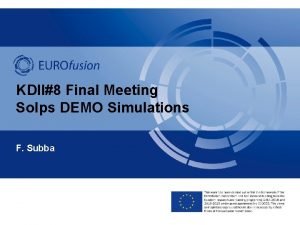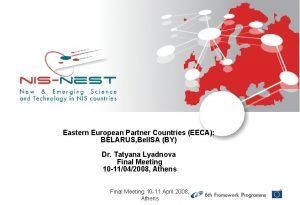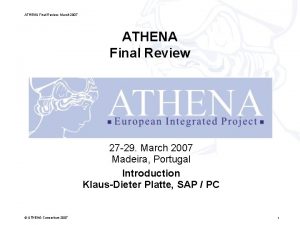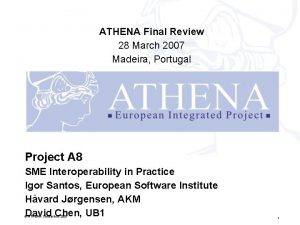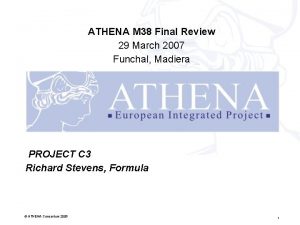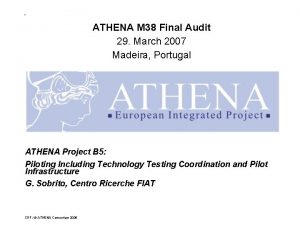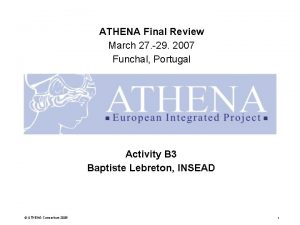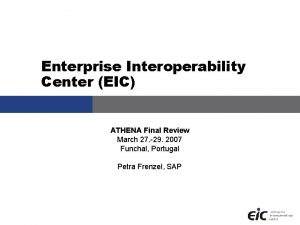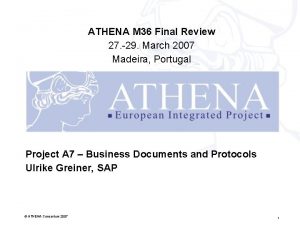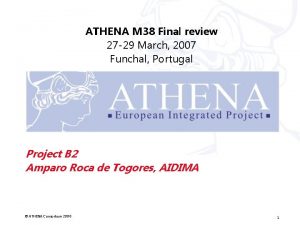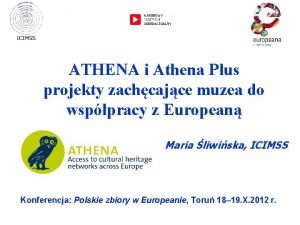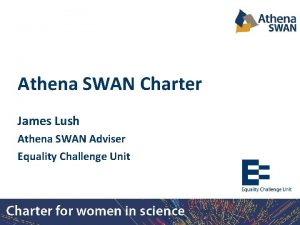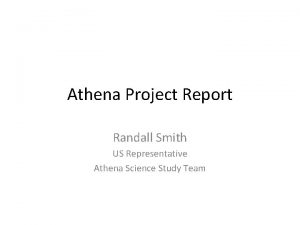ATHENA Final Review Meeting 27 29 March 2007
















- Slides: 16

* ATHENA Final Review Meeting 27 -29 March 2007 Madeira, Portugal Activity B 4 Nicolas Figay, EADS CCR Maria Anastasiou, INTRACOM S. A. © ATHENA Consortium 2007

* Agenda § § Project Objectives Overview Major Achievements for this period B 4 in a nutshell © ATHENA Consortium 2007 2

* Project Objectives § To continuously collect and synthesize industrial user requirements, and provide them to Action Line A through iterative input and feedback loops. § To provide ATHENA and in future EIC with: · · A Method for defining interoperability requirements, prioritizing interoperability issues to be address by ATHENA, ensuring traceability from the requirements to the generic and specific solutions A System to support the definition, storage, retrieval, sharing, validation, analysis, negotiation and traceability of the requirements and associated solutions A set of Scenarios that capture industry specific requirements and their analysis results An Approach to support requirements mapping with interoperability issues © ATHENA Consortium 2007 3

* Overview Actual Situation © ATHENA Consortium 2007 4 Final ATHENA Review

* Collection of Additional Scenarios • New scenarios were described based on the templates and methods of Activity B 4 Scenario Industrial Sector Representative Company Inventory Visibility & Interoperability Automotive AIAG Outbound Logistics Automotive CAS Carrier and Shipper Transport - © ATHENA Consortium 2007 5

* Analysis of new scenarios • Analysis of the scenarios: – Requirements on DRDS – Classification of the requirements – Commonalities and differential factors © ATHENA Consortium 2007 6

* Refinement of Mapping approach Objectives of Mapping approach was developed in order to: § Track the specific solutions that are used to solve specific needs and requirements defined in the Business Scenarios § To filter this correspondence through a level of abstraction (generic needs/issues against generic solution) in order to: - allow factorization of common needs coming from different sectors (Aerospace, Telecom, Furniture, Automotive…) or family of application (SCM, e-Procurement, PLM, Portfolio Management…) - apply gain know-how during ATHENA through the AIF (generic solutions and needs are structured by the AIF) - Obtain a knowledge base that will allow to continuously improve efficiency of AIF and associated methodology through analysis © ATHENA Consortium 2007 7

* Mapping Approach Overview Specific Requirements B 4 Specific Solutions Ax Projects Generalization Interoperability Issues B 4 A 4 Generalization Contextualized Issues and Solutions Contextualization ATHENA Generic Solution A 4 B 5 Contextualization Context Elements (from A 4) Mapped issues and solutions are those belonging to the same contexts or set of contexts. Several analysis viewpoints may exist, related to set of context. © ATHENA Consortium 2007 8

* Realization of mapping approach § All interoperability issues derived by ATHENA industrial users’ scenarios were contextualized. § Protégé toolset was used: – Contextualization of business needs, generic solutions & specific solutions – Analysis capabilities: • Graphical analysis based on the Jambalaya plug-in • SPARQL queries for filtering and combining context elements. © ATHENA Consortium 2007 9

* Analysis of mapping results I § 50% of interoperability issues are addressed by 3 Generic Solutions: · · · § § “Transform Model horizontally”, “Create compatible (common) views”, “Enrich Models”. This makes the rest 50% of Business Needs scattered in the other 15 Generic solutions. 70% of interoperability issues with regard to collaboration type “virtual enterprises centrally coordinated” have a GS, 19% of issues related to collaboration type “buy-sell” have a GS. 60% of interoperability issues are addressed on the “systems and technology” area of concern, while on the “security and trust” area, 2% of business requirement are addressed. Lack of specific solution was identified (e. g. horizontal transformation of source code is required for customisation ) Integration and implementation gaps © ATHENA Consortium 2007 10

* DRDS § An interface between owl (Protégé) and the DRDS requirements database was provided § Application of the introduced processes to perform requirements management and DRDS revision § Helping the new and existing ATHENA partners to use the DRDS for elaborating requirements and analysis along the requirements definition process § Provide new interfaces (RDF for analysis with open source tools like Protégé) § Support the development and implementation of the mapping methodology between Requirements and Athena Results (Solutions) § Continuous Requirements Management © ATHENA Consortium 2007 11

* B 4 Activity In an Nutshell © ATHENA Consortium 2007 12

* ATHENA Dynamic Requirements Definition Process Market External world ATHENA Requirements Handling P 2 Select Generic Requirements B 4 P 1 Select Specific Requirements Generic Requirements P 6 Develop Generic IT Products ATHENA Requirements List of potential generic solution P 3 Elaborate ATHENA requirements Specific Requirements P 4 Search for Generic Solutions P 5 Develop Generic Solutions ATHENA Research Scenarios © ATHENA Consortium 2007 • WP. B 4. 1 • D. B 4. 1 Generic solutions ATHENA Piloting P 7 Develop Specific IT Products Test Scenarios, Demonstration 13

Scenarios mapped with Interoperability Issues * © ATHENA Consortium 2007 14

* Mapping Approach Specific Requirements B 4 Specific Solutions Ax Projects Generalization Interoperability Issues B 4 A 4 Generalization Contextualized Issues and Solutions Contextualization ATHENA Generic Solution A 4 B 5 Contextualization Context Elements (from A 4) © ATHENA Consortium 2007 15

* DRDS • A clearly defined process for managing interoperability requirements • A computer system called DRDS to support this process. • 689 interoperability requirements have been collected and are stored in the DRDS Database (January 1 st 2007). © ATHENA Consortium 2007 16
 March march dabrowski
March march dabrowski Ap gov review final exam review
Ap gov review final exam review Office live meeting 2007
Office live meeting 2007 Final meeting
Final meeting Final meeting
Final meeting For today's meeting
For today's meeting Proposal kickoff meeting agenda
Proposal kickoff meeting agenda What is meeting and types of meeting
What is meeting and types of meeting Types of meeting
Types of meeting World history spring final exam review answers
World history spring final exam review answers World history and geography final exam study guide
World history and geography final exam study guide Spanish 1 semester 1 final exam answer key
Spanish 1 semester 1 final exam answer key Pltw human body systems final exam review
Pltw human body systems final exam review Poe practice test kinematics answers
Poe practice test kinematics answers Ied final exam review
Ied final exam review World history semester 2 final review packet
World history semester 2 final review packet World history semester 2 exam review
World history semester 2 exam review



